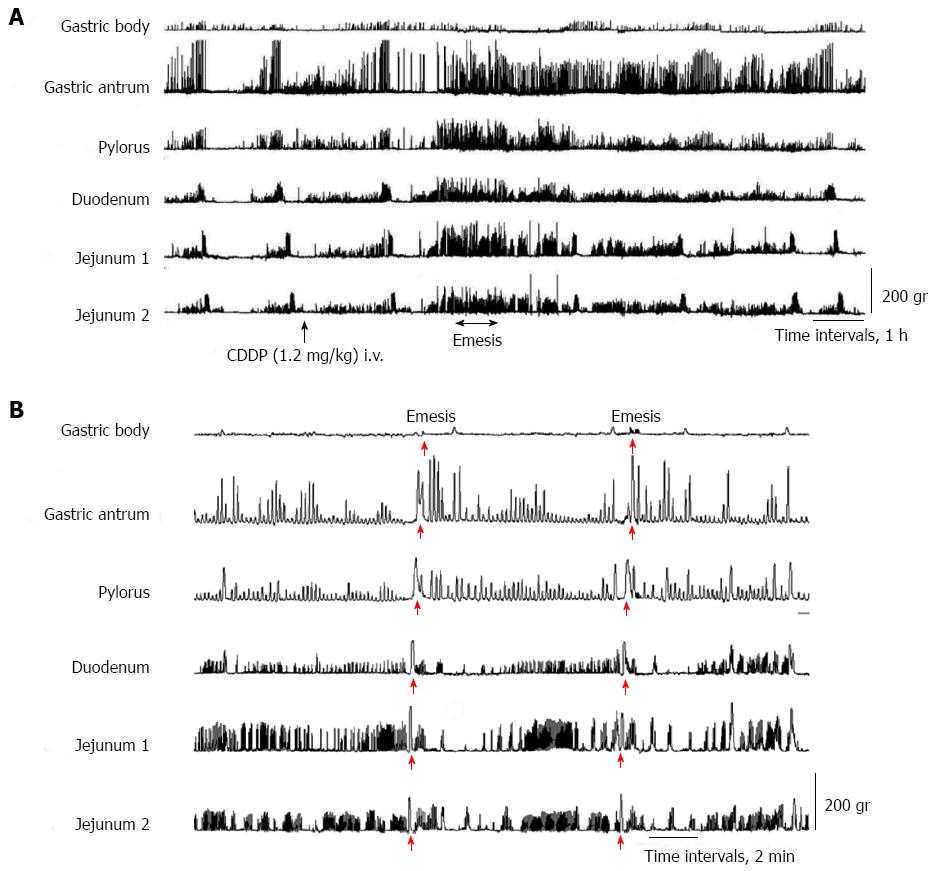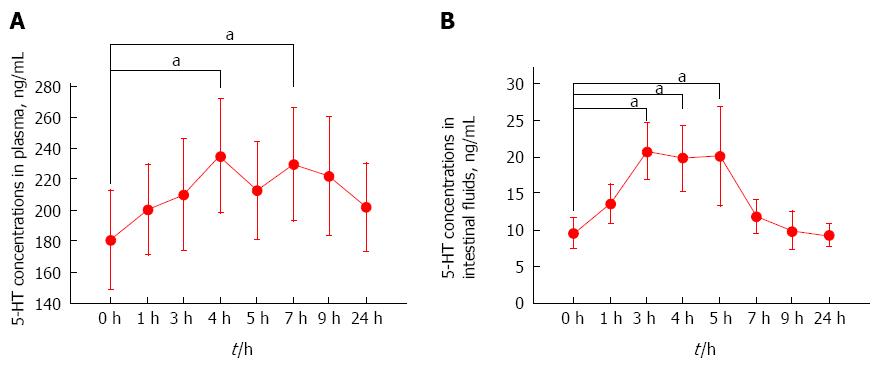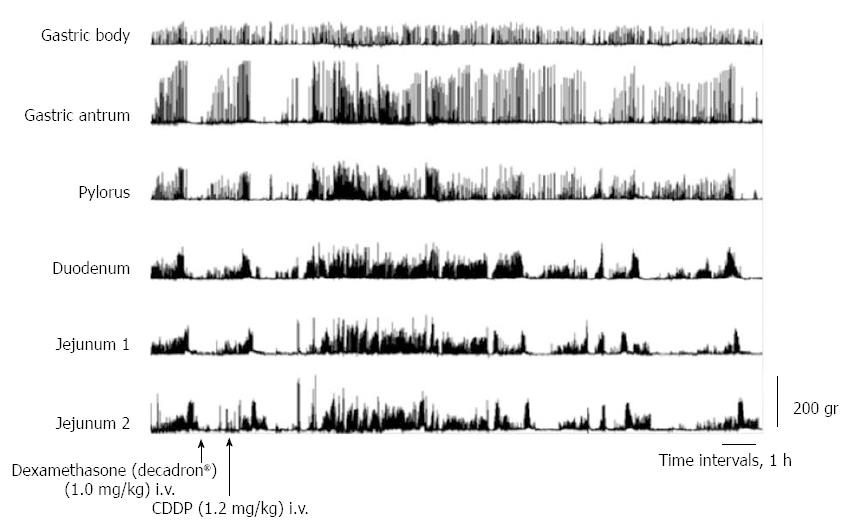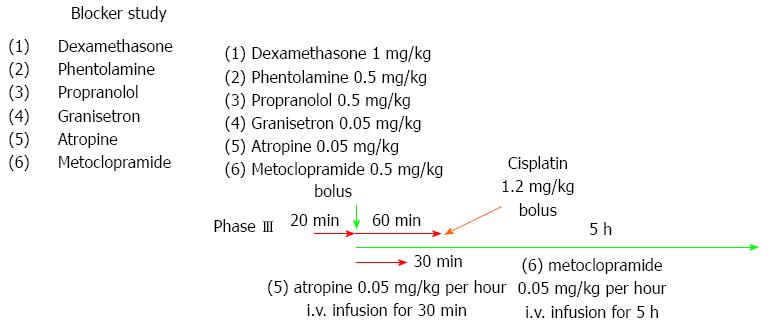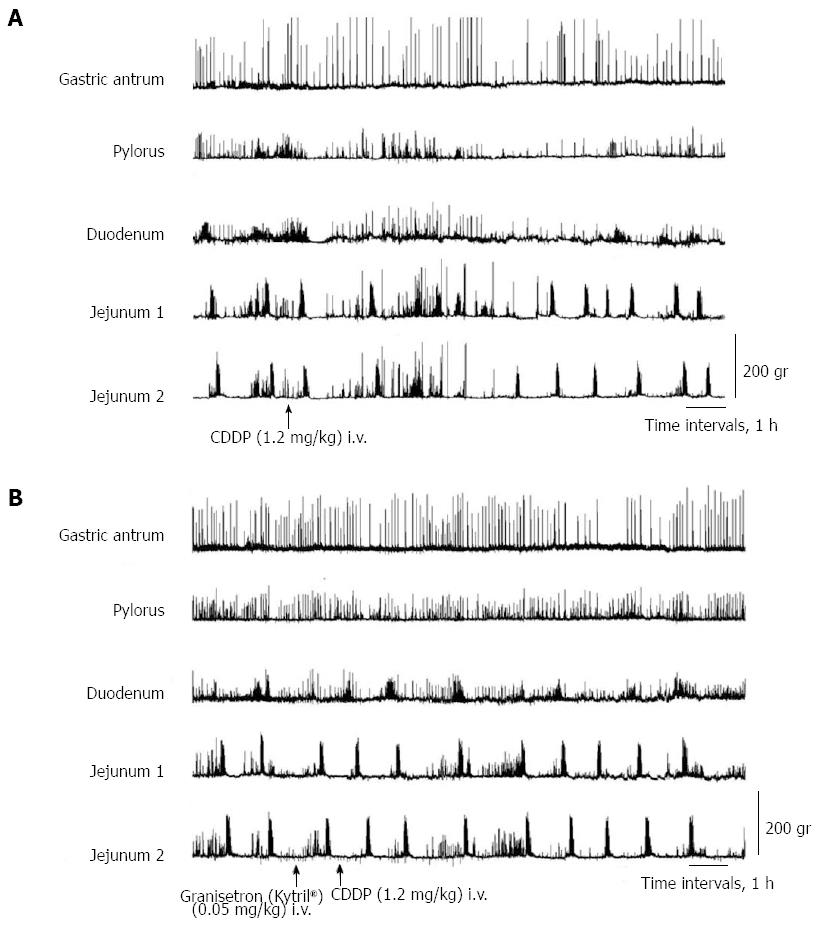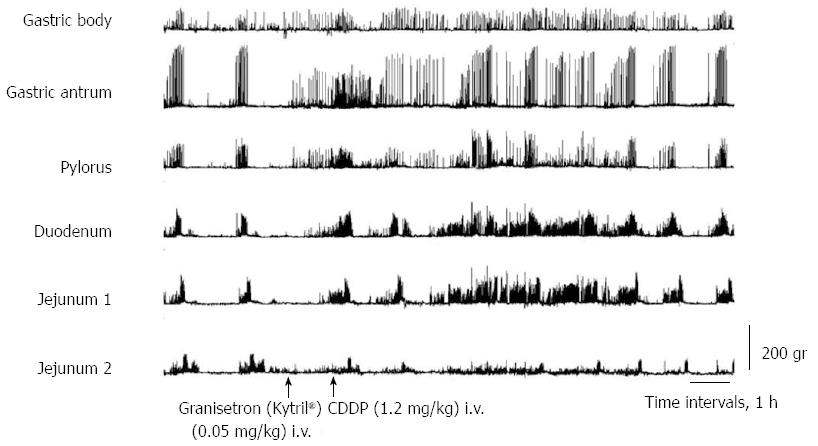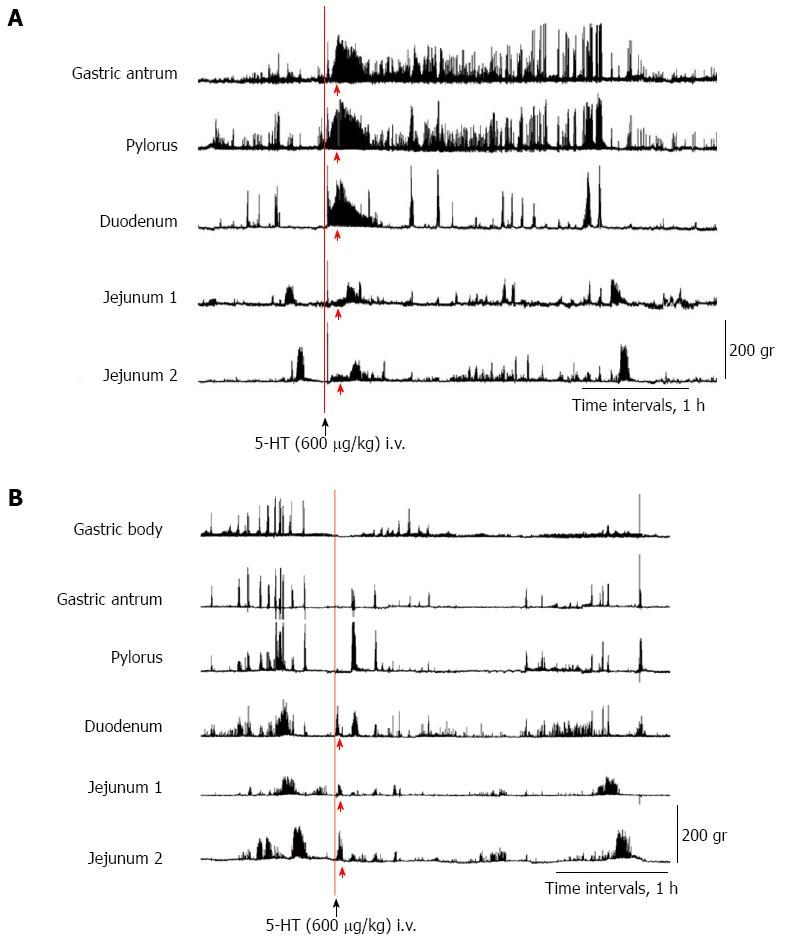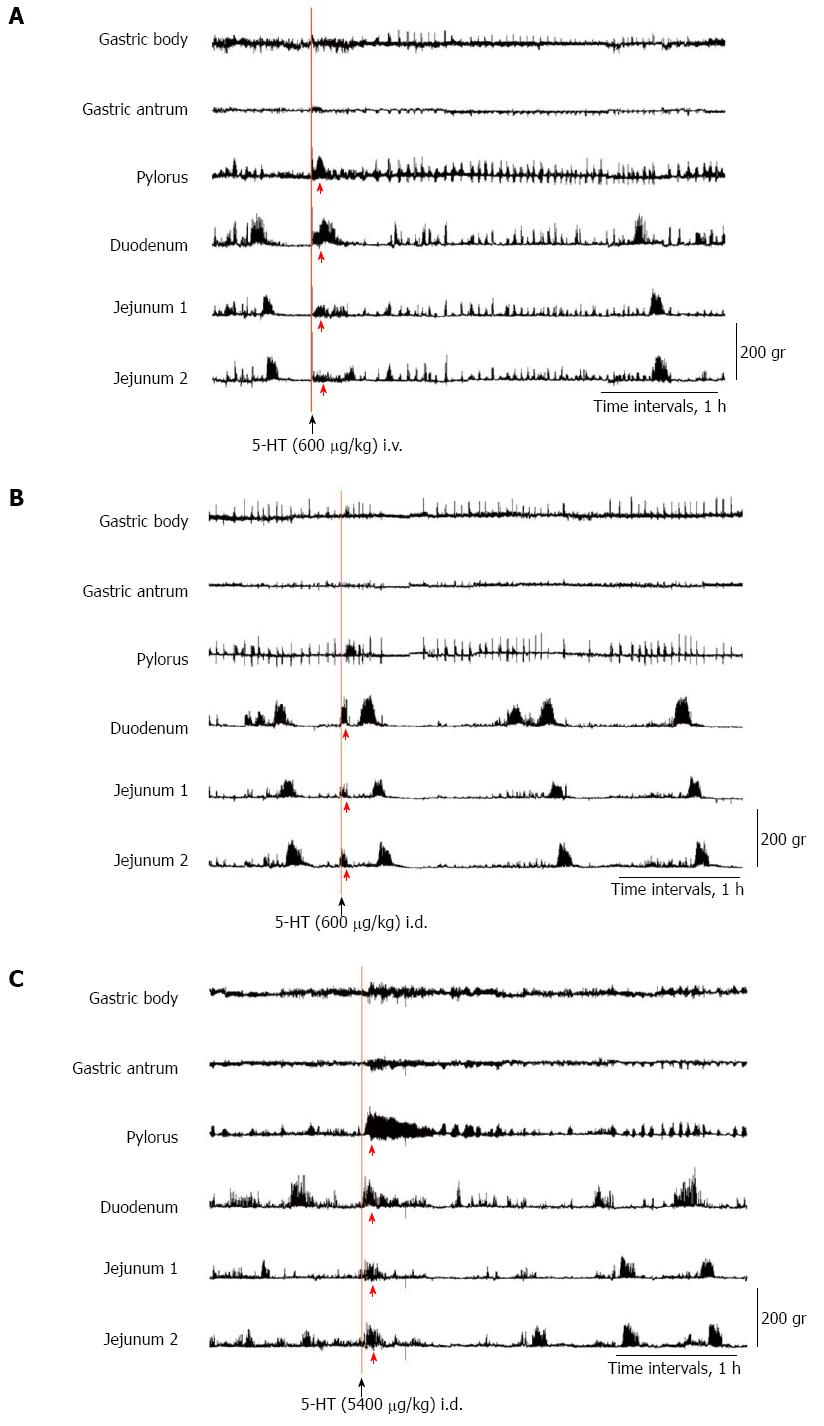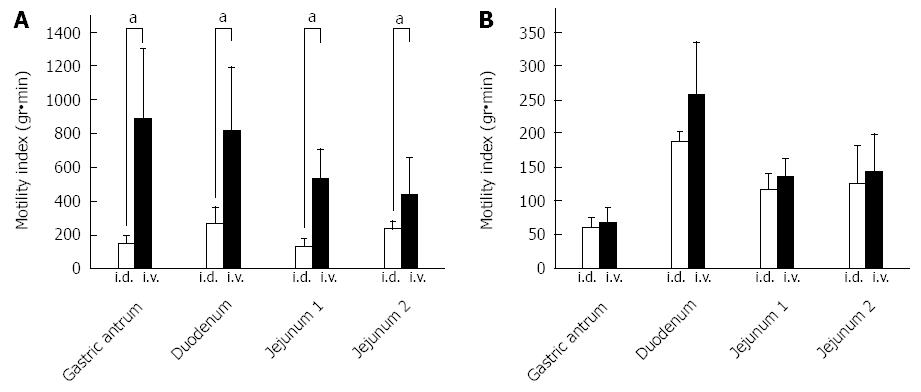Copyright
©2014 Baishideng Publishing Group Inc.
World J Gastroenterol. Nov 14, 2014; 20(42): 15691-15702
Published online Nov 14, 2014. doi: 10.3748/wjg.v20.i42.15691
Published online Nov 14, 2014. doi: 10.3748/wjg.v20.i42.15691
Figure 1 Interdigestive motor activity observed after intravenous administration of cisplatin (1.
2 mg/kg). A: Interdigestive motor activity was observed in the ND (n = 10); B: From approximately 3 to 4 h after the intravenous administration of cisplatin, the ND exhibited retropropagation of gastrointestinal motor activity from jejunum 2 to the gastric body, accompanied by emesis. ND: Normal intact dog group; i.v.: Intravenous administration.
Figure 2 Changes in concentrations of 5-hydroxytryptamine in plasma and intestinal fluids.
A: Changes in the plasma 5-HT concentrations in ND (n = 10). Each symbol represents mean ± SE. The plasma 5-HT concentration obtained at 0 h was significantly higher than those obtained at 4 and 7 h (aP < 0.05); B: Changes in the 5-HT concentrations in intestinal fluids in ND (n = 10). Each symbol represents mean ± SE. The 5-HT concentration in intestinal fluids at 0 h was significantly higher than those obtained at 3, 4, and 5 h (aP < 0.05). 5-HT: 5-hydroxytryptamine; ND: Normal intact dog group.
Figure 3 In normal intact dog group, cisplatin (1.
2 mg/kg) was given 1 h after dexamethasone administration (1.0 mg/kg), and interdigestive motor activity was observed.
Figure 4 Blocker study chart.
In the ND, dexamethasone (1 mg/kg), phentolamine (regitin; 0.5 mg/kg), propranolol (inderal; 0.5 mg/kg), or granisetron (kytril; 0.05 mg/kg) was given as a single-bolus injection starting 20 min after the spontaneous phase III contractions of the jejunum 2 had terminated. Kytril (0.05 mg/kg) was also given as a single-bolus injection in the ND and NDRVN (n = 4). Cisplatin (1.2 mg/kg) was given 1 h after the administration of each inhibitor. In ND, atropine (0.05 mg/kg + 0.05 mg/kg per hour) was given as a single-bolus injection, followed by a 30-min continuous intravenous infusion starting 20 min after the spontaneous phase III contractions of the jejunum 2 had terminated. In the ND, metoclopramide (0.5 mg/kg + 0.5 mg/kg per hour) was given as a single-bolus injection, followed by a 5-h continuous intravenous infusion starting 20 min after the spontaneous phase III contractions of the jejunum 2 had terminated. Cisplatin (1.2 mg/kg) was given 1 h after the start of the administration of each inhibitor. ND: Normal intact dog group; NDRVN: Normal intact dog group with resection of the vagus nerve; i.v.: Intravenous administration.
Figure 5 In normal intact dog group with resection of the vagus nerve, interdigestive motor activity was observed after the intravenous administration of cisplatin (1.
2 mg/kg). A: Normal intact dog group with resection of the vagus nerve (NDRVN) (n = 4) was given cisplatin (1.2 mg/kg), and interdigestive motor activity was observed; B: In the NDRVN (n = 4), cisplatin (1.2 mg/kg) was given 1 h after granisetron (kytril) administration (0.05 mg/kg), and interdigestive motor activity was observed. i.v.: Intravenous administration.
Figure 6 In the normal intact dog group (n = 6), cisplatin (1.
2 mg/kg) was given 1 h after granisetron (kytril) administration (0.05 mg/kg), and interdigestive motor activity was observed.
Figure 7 Numbers of emetic episodes in dogs receiving cisplatin alone (control, n = 10), kytril (0.
05 mg/kg, intravenous administration, n = 6) alone, and vagotomy (the normal intact dog group with resection of the vagus nerve; n = 4). Each bar represents mean ± SE. Significant differences were detected among the control group, granisetron (kytril) group, and normal intact dog group with resection of the vagus nerve (NDRVN). Control, open bar; i.v., hatched line; RNG, filled bar. aP < 0.05 vs control. i.v.: Intravenous administration.
Figure 8 Responses to the intravenous and duodenal administration of 5-hydroxytryptamine in the normal intact dog group.
A: Responses to the intravenous administration of 5-hydroxytryptamine (5-HT) (600 μg/kg) in the ND; B: Responses to the duodenal administration of 5-HT (600 μg/kg) in the ND. ND: Normal intact dog group; i.v.: Intravenous administration; i.d.: Intraduodenal administration.
Figure 9 Responses to the intravenous and duodenal administration of 5-hydroxytryptamine in the normal intact dog group with resection of the vagus nerve.
A: Responses to the intravenous administration of 5-HT (600 μg/kg) in the NDRVN; B: Responses to the duodenal administration of 5-HT (600 μg/kg) in the NDRVN; C: Responses to the duodenal administration of 5-HT (5400 μg/kg) in the NDRVN. NDRVN: Normal intact dog group with resection of the vagus nerve; 5-HT: 5-hydroxytryptamine, serotonin; i.v.: Intravenous administration; i.d.: Intraduodenal administration.
Figure 10 Motility index during 60 min following 5-hydroxytryptamine administration.
A: MI during 60 min following 5-HT administration (600 μg/kg) was calculated in the ND (n = 4); B: MI during 60 min following 5-HT administration (600 μg/kg) was calculated in the NDRVN (n = 4). Open bar, i.d. administration; filled bar, i.v. administration. aP < 0.05. NDRVN: Normal intact dog group with resection of the vagus nerve; MI: Motility index; ND: Normal intact dog group; 5-HT: 5-hydroxytryptamine, serotonin; i.v.: Intravenous administration; i.d.: Intraduodenal administration.
- Citation: Ando H, Mochiki E, Ohno T, Yanai M, Toyomasu Y, Ogata K, Tabe Y, Aihara R, Nakabayashi T, Asao T, Kuwano H. Mechanism of gastrointestinal abnormal motor activity induced by cisplatin in conscious dogs. World J Gastroenterol 2014; 20(42): 15691-15702
- URL: https://www.wjgnet.com/1007-9327/full/v20/i42/15691.htm
- DOI: https://dx.doi.org/10.3748/wjg.v20.i42.15691









